Abstract
Thirty-gauge needles are generally not recommended by dental schools, yet many dentists use them. Thin needles (30 gauge) can aspirate blood, have similar deflection to thick needles (25 gauge), and resist breakage. Measurable clinical differences between inferior dental block injections using 25-gauge or 30-gauge short needles for children is addressed in this research paper. Random allocation assigned 76 cases to 30-gauge and 62 cases to 25-gauge tribeveled. Twenty-seven-gauge short needles are in routine use for inferior dental nerve block injections in our clinics. After informed written consent was obtained, inferior dental block injections were carefully administered to children (62 males and 76 females, mean age 10 years ± 3 [SD], range 4—18 years) by faculty and students in pediatric dentistry and observed by one of two trained observers. After aspiration in two planes (180°), 0.5 mL of 2% lidocaine with 1:100,000 epinephrine was deposited in the lingual block area then 1.0 mL in the inferior dental area after touching bone. Any aspirate was recorded and subjective pain scores were taken immediately using a visual analogue scale. Five minutes after the commencement of the injection, the efficacy was tested objectively by two light needle pricks of the mucosa adjacent to the cuspid. The comparability of groups as regards age and sex was verified. Half of the injections were effective at five minutes in each group. There were no significant differences in efficacy, or pain scores. Both 25- and 30-gauge groups had nine instances of slight aspiration and two instances of more marked aspirations. The overall aspiration rate was 16%. It is concluded that 25- and 30-gauge needles do not differ significantly with respect to efficacy, pain, or aspiration. Children do not think that inferior dental nerve block injections hurt very much, and there is no evidence to support a change from 25- to 30-gauge needles.
Full text
PDF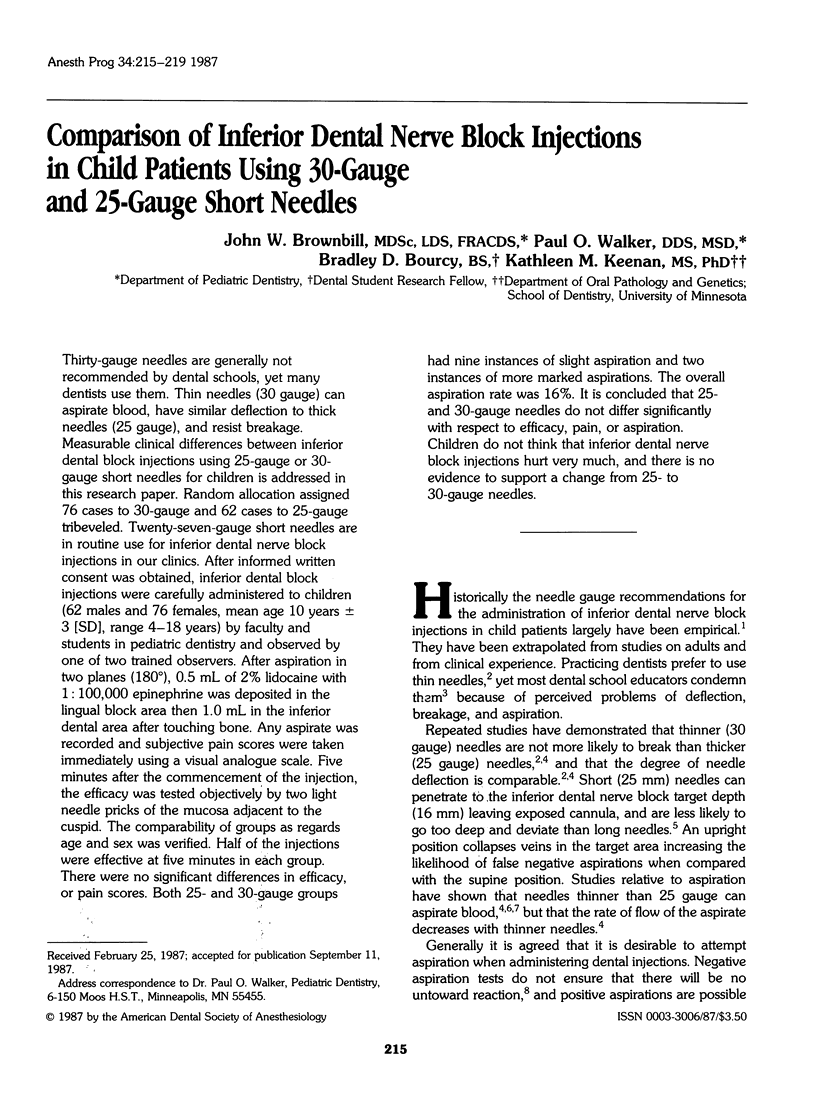
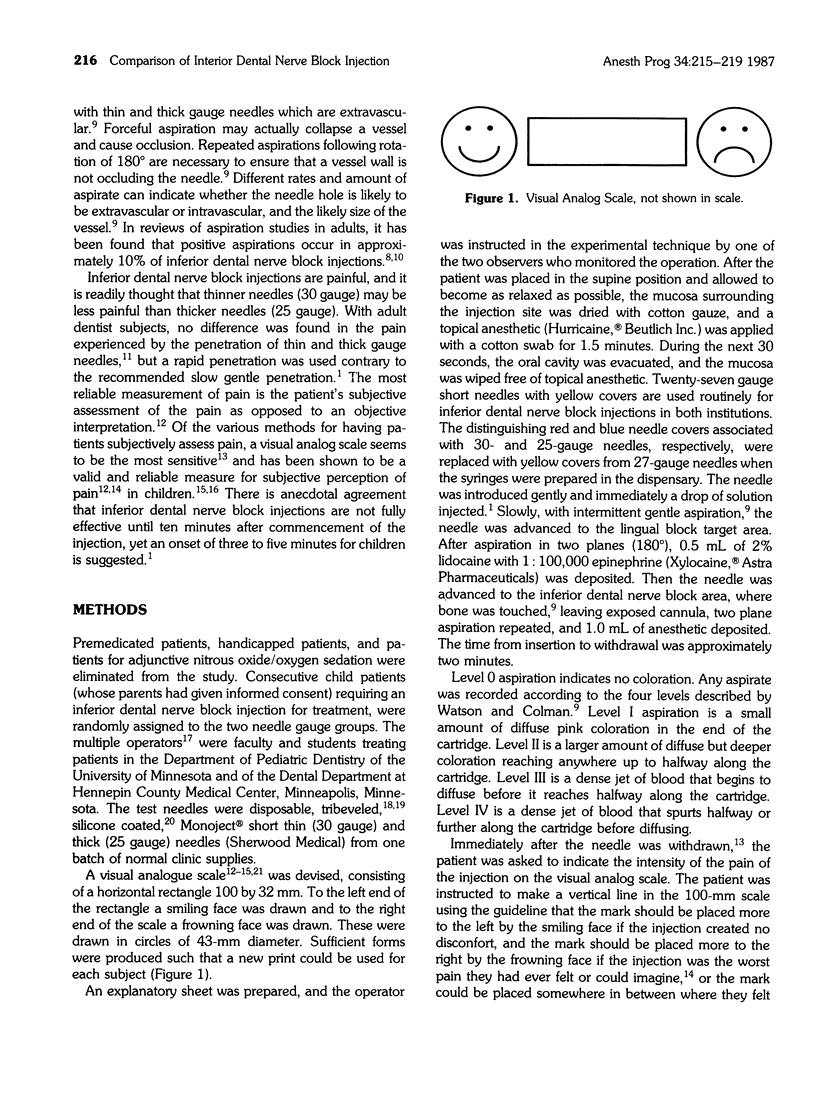
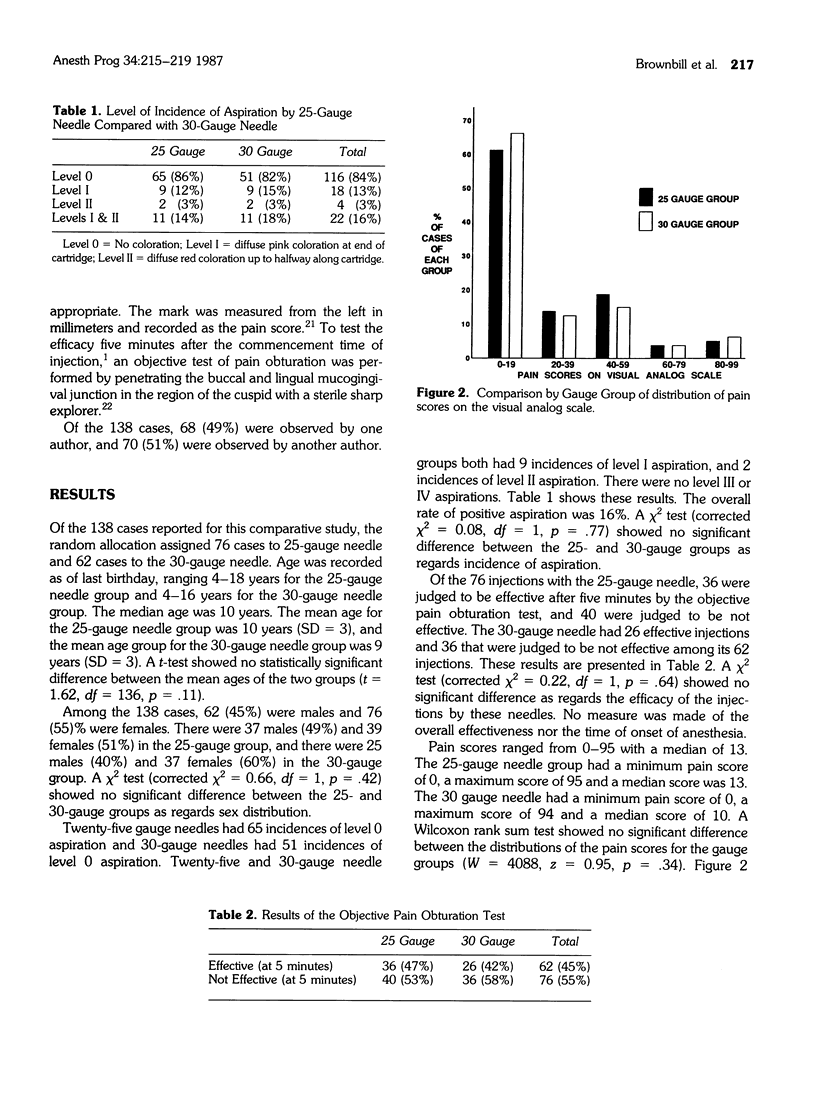
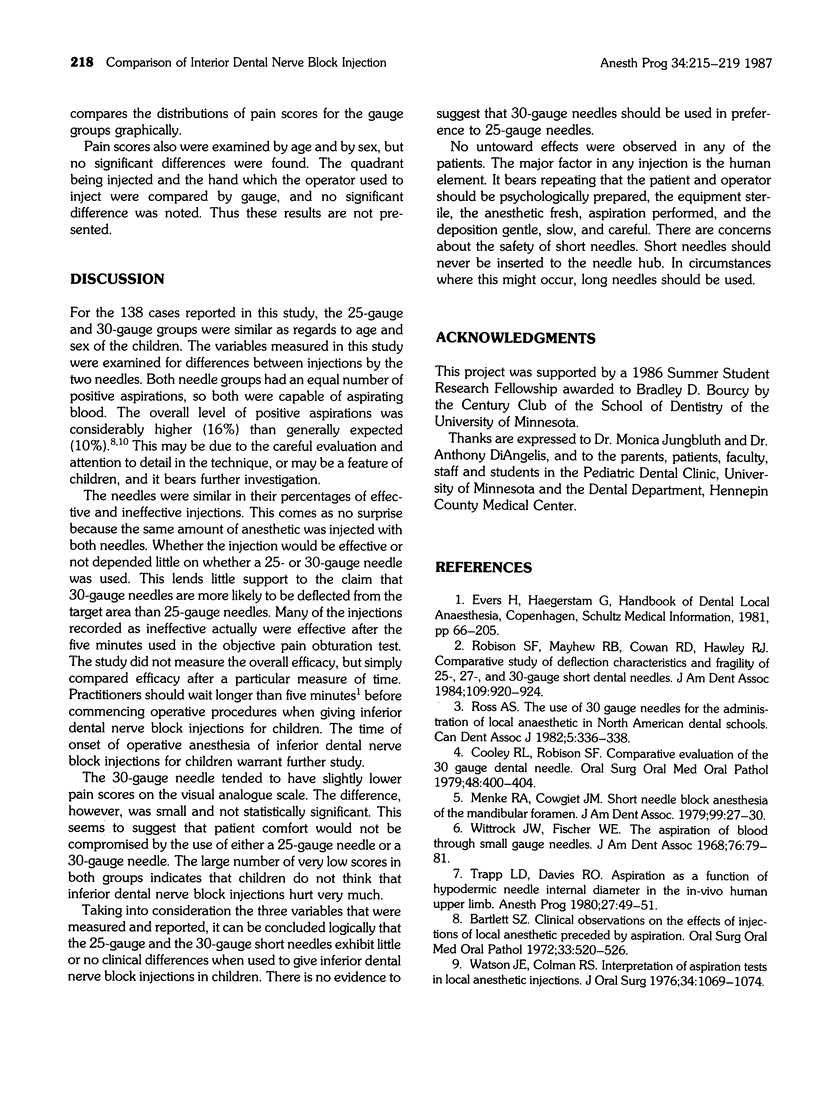
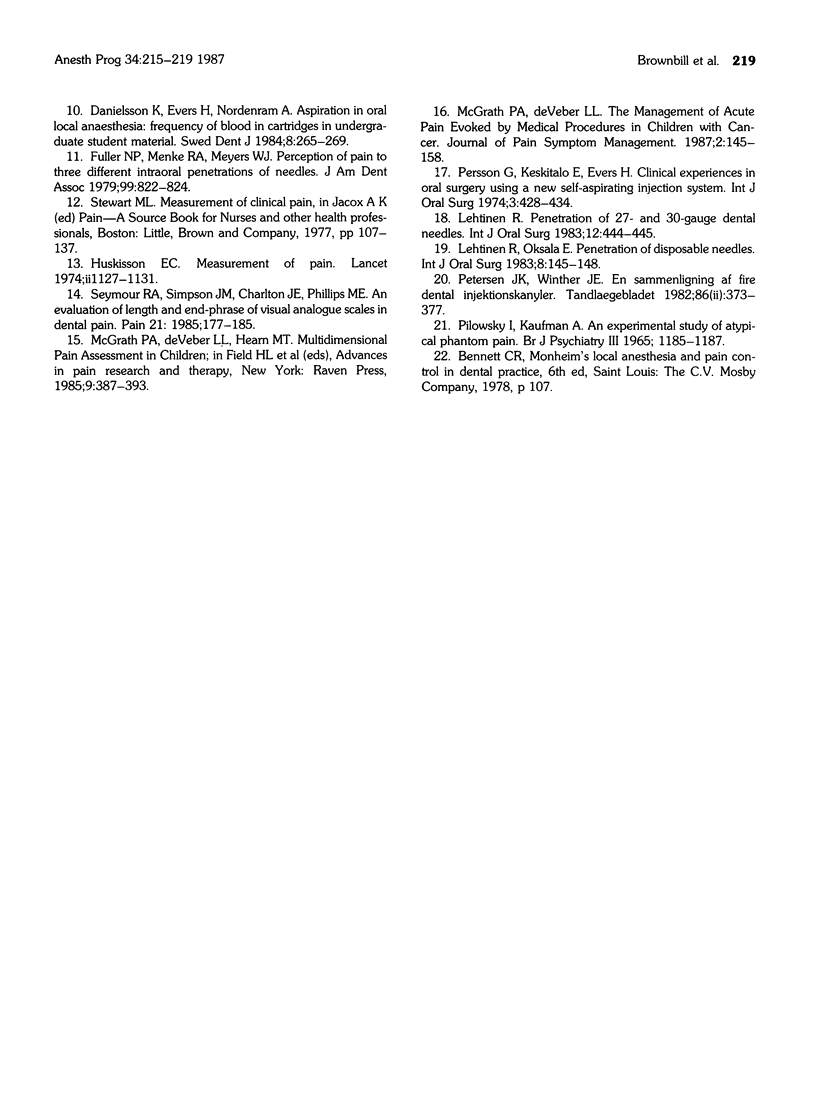
Selected References
These references are in PubMed. This may not be the complete list of references from this article.
- Bartlett S. Z. Clinical observations on the effects of injections of local anesthetic preceded by aspiration. Oral Surg Oral Med Oral Pathol. 1972 Apr;33(4):520–526. doi: 10.1016/0030-4220(72)90363-5. [DOI] [PubMed] [Google Scholar]
- Cooley R. L., Robison S. F. Comparative evaluation of the 30-gauge dental needle. Oral Surg Oral Med Oral Pathol. 1979 Nov;48(5):400–404. doi: 10.1016/0030-4220(79)90065-3. [DOI] [PubMed] [Google Scholar]
- Danielsson K., Evers H., Nordenram A. Aspiration in oral local anaesthesia. Frequency of blood in cartridges in an undergraduate student material. Swed Dent J. 1984;8(6):265–269. [PubMed] [Google Scholar]
- Fuller N. P., Menke R. A., Meyers W. J. Perception of pain to three different intraoral penetrations of needles. J Am Dent Assoc. 1979 Nov;99(5):822–824. doi: 10.14219/jada.archive.1979.0384. [DOI] [PubMed] [Google Scholar]
- Huskisson E. C. Measurement of pain. Lancet. 1974 Nov 9;2(7889):1127–1131. doi: 10.1016/s0140-6736(74)90884-8. [DOI] [PubMed] [Google Scholar]
- Lehtinen R., Oksala E. Penetration of disposable needles. Int J Oral Surg. 1979 Apr;8(2):145–148. doi: 10.1016/s0300-9785(79)80010-1. [DOI] [PubMed] [Google Scholar]
- Lehtinen R. Penetration of 27- and 30-gauge dental needles. Int J Oral Surg. 1983 Dec;12(6):444–445. doi: 10.1016/s0300-9785(83)80036-2. [DOI] [PubMed] [Google Scholar]
- Menke R. A., Gowgiel J. M. Short-needle block anesthesia at the mandibular foramen. J Am Dent Assoc. 1979 Jul;99(1):27–30. doi: 10.14219/jada.archive.1979.0214. [DOI] [PubMed] [Google Scholar]
- Persson G., Keskitalo E., Evers H. Cilnical experiences in oral surgery using a new self-aspirating injection system. Int J Oral Surg. 1974;3(6):428–434. doi: 10.1016/s0300-9785(74)80008-6. [DOI] [PubMed] [Google Scholar]
- Petersen J. K., Winther J. E. En sammenligning af fire dental injektionskanyler. Tandlaegebladet. 1982 Jun;86(11):373–377. [PubMed] [Google Scholar]
- Pilowsky I., Kaufman A. An experimental study of atypical phantom pain. Br J Psychiatry. 1965 Dec;111(481):1185–1187. doi: 10.1192/bjp.111.481.1185. [DOI] [PubMed] [Google Scholar]
- Robison S. F., Mayhew R. B., Cowan R. D., Hawley R. J. Comparative study of deflection characteristics and fragility of 25-, 27-, and 30-gauge short dental needles. J Am Dent Assoc. 1984 Dec;109(6):920–924. doi: 10.14219/jada.archive.1984.0246. [DOI] [PubMed] [Google Scholar]
- Ross A. S. The use of 30 gauge needles for the administration of local anaesthetic in North American dental schools. J Can Dent Assoc. 1982 May;48(5):336–338. [PubMed] [Google Scholar]
- Seymour R. A., Simpson J. M., Charlton J. E., Phillips M. E. An evaluation of length and end-phrase of visual analogue scales in dental pain. Pain. 1985 Feb;21(2):177–185. doi: 10.1016/0304-3959(85)90287-8. [DOI] [PubMed] [Google Scholar]
- Trapp L. D., Davies R. O. Aspiration as a function of hypodermic needle internal diameter in the in-vivo human upper limb. Anesth Prog. 1980 Mar-Apr;27(2):49–51. [PMC free article] [PubMed] [Google Scholar]
- Watson J. E., Colman R. S. Interpretation of aspiration tests in local anesthetic injections. J Oral Surg. 1976 Dec;34(12):1069–1074. [PubMed] [Google Scholar]
- Wittrock J. W., Fischer W. E. The aspiration of blood through small-gauge needles. J Am Dent Assoc. 1968 Jan;76(1):79–81. doi: 10.14219/jada.archive.1968.0014. [DOI] [PubMed] [Google Scholar]


